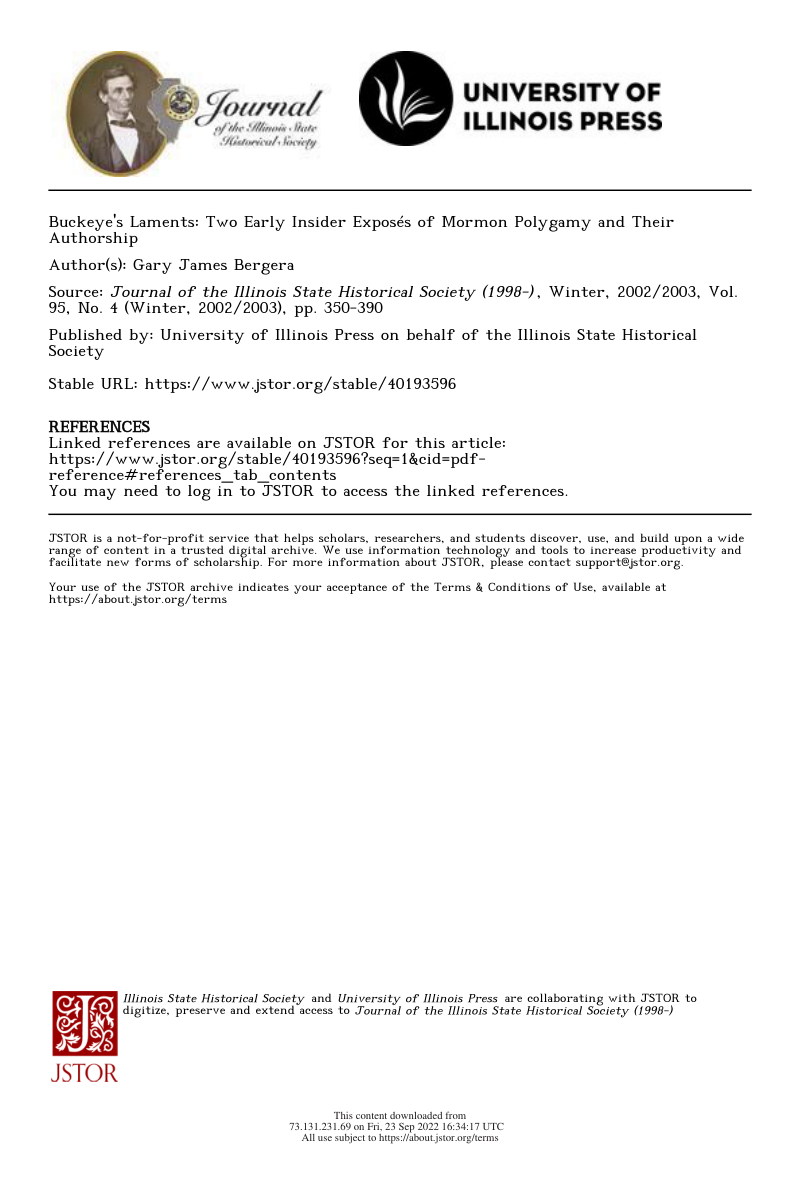Gary James Bergera reviews the likely authorship of "Buckeye's Laments" poems published in 1844; concludes probably Wilson or William Law composed them.
- Type
- Academic / Technical Report
- Source
- Gary James Bergera LDS
- Hearsay
- Secondary
- Reference
Gary James Bergera, "Buckeye's Laments: Two Early Insider Exposés of Mormon Polygamy and Their Authorship," Journal of the Illinois State Historical Society 95, no. 4 (Winter, 2002/2003): 350-390
- Scribe/Publisher
- Journal of the Illinois State Historical Society
- People
- Gary James Bergera
- Audience
- Reading Public
- Transcription
Buckeye's Laments:
Two Early Insider Exposes of Mormon Polygamy and Their Authorship
Gary James Bergera
On Wednesday, 7 February 1844, the Whig-friendly Warsaw Message published on the front page of its last issue a satirical poem critical of Mormon prophet Joseph Smith, entitled "BUCKEYE'S LAMENTATION for want of more wives." Operating on the western border of central Illinois, along the banks of the Mississippi River some twelve miles south of Nauvoo, the bustling headquarters of Smith's Church of Jesus Christ of Latter-day Saints (LDS), the Message routinely tweaked the noses of the LDS faithful. As Thomas Gregg, the paper's thirty-five-year-old editor, explained, "THE POEM In another part of this sheet, comes to us post marked 'Nauvoo.' It is not perfect in versification, but contains some hits at the Prophet, his Apostles, and their practices, which most readers will understand."1 Increasingly besieged by critics and renegades, the charis- matic Smith learned later that day of the thirteen-stanza, 104-line poem and, according to his official History, immediately dismissed it as "a piece of doggerel . . . evidently the production of Wilson Law [a Mormon dissident], and breathing a very foul and malicious spirit."2
A veteran journalist, the feisty Gregg represented a growing number of Illinoisans who were becoming increasingly leery of the Mormons' political and theocratic hegemony.3 Less than five months earli- er, in late September 1843, Gregg had editorialized that while he despised "the whole system of Mormonism," he nonetheless urged nonviolence: "Let it suffice for the present to say that our remedy must be a peaceable one - a remedy that will not interfere with the Majesty and Supremacy of the Law! We can advocate no measure of redress that does not carry along with it the doctrine of Obedience to the Laws, from the beginning to the end."4
Two months after its appearance, "Buckeye's Lamentation" togeth- er with a longer, but equally cheeky companion poem entitled "The Buckey's [sic] First Epistle to Jo," ran on pages 3 and 1, respectively, of the successor to the Message, the Warsaw Signal, edited by twenty-five-year-old Thomas C. Sharp. (Sharp's Signal was actually the forerunner of the Message. He had sold the paper to Gregg, who renamed it, operated it for several years, then sold it back to Sharp.) Like Gregg, Sharp opposed Mormonism; unlike Gregg, he would eventually advocate its violent overthrow. "War and extermination is inevitable!" he would thunder against the hapless Mormons before year's end. "Citizens ARISE, ONE and ALL!!!- Can you stand by, and suffer such INFERNAL DEVILS! to ROB men of their property rights, without avenging them. We have no time for comment, every man will make his own. Let it be made with POWDER and BALL/'5
"Buckey's First Epistle," running twenty-two stanzas of six lines each, totaled 132 lines. "Buckeye's Lamentation" reappeared with only minor alterations, mostly the converting of italics to small capital letters, though four words were changed. Two days after both poems' publication on 25 April, Joseph Smith's diary noted his reading the "Warsaw Signal about Mormonism." Smith's later history added that he "read in the Warsaw Signal a vile article against the Saints."6 Since the next issue of the weekly Signal did not appear until 1 May, the thirty-eight-year-old Mormon prophet no doubt had the two poems in mind when he allegedly complained of the paper's contents.
The value of Buckeye's poetry lies not in its creative expression but in its accurate, albeit sensationalized, historical disclosures.7 By 1844, Joseph Smith's doctrine of plural, or celestial, marriage had become one of western Illinois's better-known secrets. Despite his and others' denials, Smith himself had married (or been "sealed" to) some thirty women, while thirty or so of his closest male disciples had taken a total of at least an equal number of plural wives.8 These figures do not include the parents, siblings, children, friends, and neighbors of those involved in the new teaching. The poems evince an understanding not only of polygamy's practice but, just as importantly, of its theology. Buckeye was a knowledgeable insider-turned- dissident who hoped to expose Smith's marital innovations - particularly with a young woman named Nancy - while also dropping enough hints of his own person to enable a tentative identification. (Both poems appear as an appendix to this article.)
. . .
- Citations in Mormonr Qnas
The B. H. Roberts Foundation is not owned by, operated by, or affiliated with the Church of Jesus Christ of Latter-day Saints.

